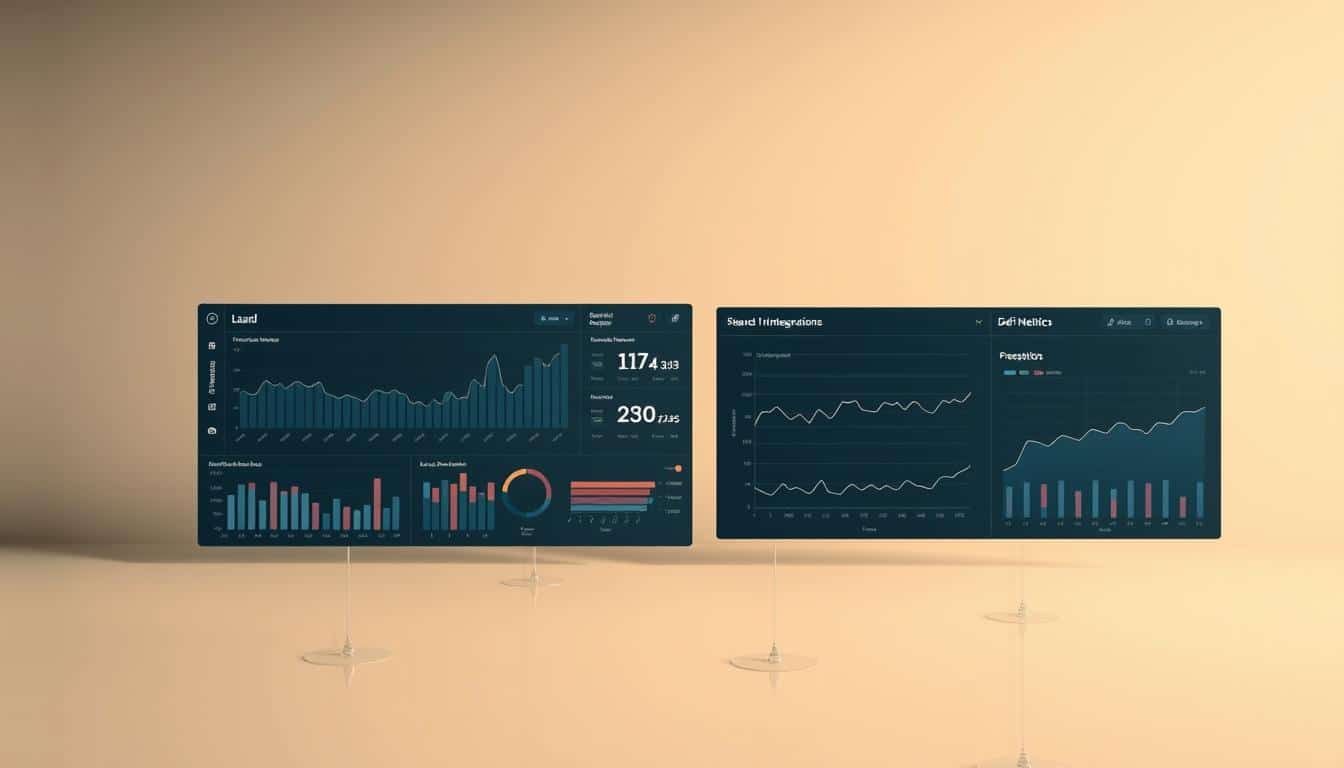Create a DeFi Dashboard Using APIs – A Step Guide
About 40% of people who invest in crypto often check lending rates and project funds. This fact makes a good dashboard vital. I’ll teach you how to create a DeFi dashboard with APIs. This lets you track loans, swaps, total value, and how your investments are doing live.
This guide comes from real experience: building DeFi dashboards using different APIs and tools like Prometheus and Grafana. You’ll learn to track live prices, your wallet, loans, and more with clear charts.
If you like building things yourself or if you’re creating products in the U.S., this guide is full of information. It goes over setting up, adding tools, connecting APIs, showing data, analyzing it, and improving the user experience. It even covers how AI could help with dashboards for alerts and insights.
Lending rates vary a lot, from 2.5% to 14%. That’s why having a dashboard that updates instantly is crucial. By following this guide from the basics to keeping it running, you’ll learn how to make one step by step.
Key Takeaways
- Learn how to build DeFi dashboard with APIs to surface prices, positions, and protocol metrics.
- Hands-on DeFi dashboard development uses public/commercial APIs plus observability tools like Prometheus and Grafana.
- Real-time feeds and on-chain data are core goals: wallet balances, LP stakes, swaps, and TVL.
- DeFi dashboard tools and integrations can scale into agentic workflows for automated alerts and context.
- This guide is practical and aimed at DIY developers and crypto product builders in the United States.
Understanding DeFi and Its Importance
Decentralized finance, also known as DeFi, has grown from small tests to big projects handling real money. It allows financial services, like lending and trading, directly between people on public blockchains. This is big news for developers, traders, and anyone interested in money without needing a middleman.
Overview of Decentralized Finance
DeFi offers services like lending, borrowing, and making swaps on decentralized exchanges, all on networks such as Ethereum. People can lend their crypto to earn interest, while borrowers can get loans without having to sell their assets. This was first shown by platforms like Celsius Network and BlockFi, which demonstrated the demand for crypto lending and set the stage for what returns people could expect.
The returns you get, known as APYs, can vary. Some safe investments might give you a 2.5% return, while riskier ones can offer much more. Knowing this helps if you’re creating a DeFi dashboard. You’d need to collect data on lending rates, how much collateral is needed, and the prices for swaps from different sources.
How DeFi Impacts Traditional Finance
DeFi makes it less necessary to rely on banks by allowing everyone access to financial services without permission. This change encourages quicker innovation and makes it easier for people to bring new ideas to finance. Different DeFi services can also be combined to create new financial products.
Yet, there are new risks. Issues in the software code and the risk of dealing with unknown parties replace some of the old risks of centralized finance. Also, rapid changes in market prices can threaten loans secured by crypto. These factors are important to consider when making tools to monitor and alert users within a DeFi dashboard.
Key Benefits of a DeFi Dashboard
Having a good DeFi dashboard means you can see all your financial details in one place. It shows the interest rates for lending, the status of loans, and the total value locked in DeFi protocols. Dashboards help monitor passive income and compare different DeFi services without having to switch between many different sites.
You can use dashboards to keep an eye on returns ranging from 2.5% to 14%, watch the health of your collateral, and notice changes in total value that might affect liquidity. A well-designed dashboard will use modern tools for alerts and monitoring to help you stay on top of everything.
When building a DeFi dashboard with APIs, start simple. Choose trustworthy data sources, standardize the information, and highlight key figures. Automating alerts for unusual activities can help prevent financial losses or missed opportunities.
Essential Tools for Building Your Dashboard
When I build dashboards, I start with planning. I look at the data sources, the programming languages, and the chart types. Choosing the right tools helps speed up the development. It also makes adjusting the dashboard simpler if needs change.
Popular APIs for DeFi Data
Knowing about DeFi data providers is crucial. Price updates come from CoinGecko, CoinMarketCap, and Chainlink. The Graph, Etherscan, and protocol SDKs from Aave and others provide on-chain data and lending metrics.
For simpler data handling across various blockchains, consider Covalent or Alchemy. They help with data aggregation. This choice will shape how you manage data and how accurate your DeFi tools are in real-time.
Recommended Programming Languages
I prefer JavaScript or TypeScript for quick prototyping and front-end work. Pairing React with TypeScript helps manage the UI and data smoothly, especially when using multiple DeFi APIs.
Python is great for analyzing data, with libraries like pandas and NumPy. For strong back-end performance, consider using Go or Rust to reduce delay and use less memory.
Adding tools like LangChain to Python setups can improve your dashboard. They provide more context and help with searches and prompts.
Visualization Tools to Consider
Choosing the right charting tool is based on how much control and interactivity you want. D3.js offers complete design freedom. Chart.js and Plotly make it quick to create standard charts with good interaction.
For checking your dashboard’s performance, Grafana and Tableau are good picks. Using Prometheus with Grafana can monitor your backend and provide important alerts. It’s useful for keeping an eye on both backend status and market data.
When picking libraries, it helps to look at comparisons. I chose Plotly for its interaction and Grafana for alerts based on such reviews. You can find similar analyses at crypto charting tools.
| Category | Examples | Best Use |
|---|---|---|
| Price / Market | CoinGecko, CoinMarketCap, Chainlink | Fast market updates, aggregated prices |
| On-chain Indexing | The Graph (Uniswap, Aave) | Protocol-specific queries, event indexing |
| Explorers | Etherscan | Raw transactions, wallet balances |
| All-in-one APIs | Covalent, Bitquery, Alchemy | Cross-chain aggregation, standardized endpoints |
| Charting | D3.js, Plotly, Chart.js, ECharts | Interactive visuals and custom charts |
| Monitoring | Prometheus + Grafana, Tableau | Operational metrics, alerting, dashboards |
APIs and visual tools have tradeoffs. API costs can increase with use. Your choice in visualization tools should match your need for interaction. Planning these decisions from the start simplifies creating a DeFi dashboard. It helps avoid big changes later on.
Setting Up Your Development Environment
I begin every DeFi dashboard project with a well-defined dev environment. Doing this keeps everything in sync across local development, CI/CD, and production. Here, I’ll share the tech stack I prefer and discuss the importance of each part for DeFi dashboard projects. This also includes how to build these dashboards using APIs.
Installing Necessary Software
Start by installing Node.js with TypeScript for the front end. It helps manage the user interface and API interactions. Add Python 3.10 or newer for running analysis scripts and handling data. Docker is essential for creating local containers, ensuring consistency across all environments. To handle growth, set up an EKS cluster on AWS and manage it with Terraform modules. Then, use Helm charts to install Prometheus and Grafana for monitoring. This setup is great for running apps like a Voting App and for scalable, watchful management of your DeFi dashboard project.
For continuous integration and deployment, use tools like GitHub Actions, GitLab CI, or Jenkins. These tools can build container images, push them to ECR, and deploy everything with Helm to EKS. Using Terraform plus Helm helps make deployments faster, more consistent, and less prone to errors as your project grows or when adding new team members.
Configuring API Access
Sign up with API providers like CoinGecko, Alchemy, Infura, and Covalent. Get your API keys and note the rate limits for each. Whenever possible, use the provider’s SDKs to make integration easier and to better manage errors. Set up The Graph for specific protocol queries. This can help lessen the load from heavy RPC traffic.
Keep sensitive information like API keys in environment variables or a secure store. For local development, use .env files and exclude them from Git with a gitignore rule. In production settings, store your keys securely with AWS Secrets Manager or HashiCorp Vault. Caching responses and data helps reduce the need for frequent calls, making your development faster and ensuring your dashboard stays reliable, even under heavy use.
Best Practices for Security
Always keep API keys in secure storage and never upload them to version control. Implement strict IAM roles for EKS and make sure service accounts have limited access. Secure all connections with TLS/HTTPS and thoroughly check incoming data to prevent attacks. Clean inputs to avoid security risks and verify third-party SDKs for any unsafe settings.
Limits should be set on permissions for tools and their agents, and their activity should be monitored. Be cautious of prompt injection, just as you are with tool permissions. Keep a close eye on your project’s metrics and alerts with Prometheus and Grafana. Responding quickly to issues like failed scrapes, high error rates, or traffic spikes can prevent larger problems in your DeFi dashboard project.
Use Prometheus for backend metrics and make sure Grafana can access this data for visualization. Setting up alerts based on service performance and errors is crucial. These alerts help maintain service quality and ensure your DeFi dashboard works well across different settings.
Designing Your Dashboard Layout
I start with sketches before diving into code. This approach makes me think about the layout’s order, space, and how people will use it. It’s key when designing and customizing DeFi dashboards.
My advice? Begin with Figma or Sketch for prototypes, and keep it simple initially. Focus on key views: portfolio summary, protocol stats, and alerts. Design for user actions like checking detailed transactions, filtering, and selecting dates.
Creating wireframes and prototypes
- Begin with simple layouts to plan space and flow.
- Use Figma or Sketch for iterations and to test usability.
- Design for interactions like navigating from charts to details, applying filters, and exporting.
Identifying key metrics to display
Choose metrics that instantly answer users’ main questions. Compare lending rates with reliable data to show best options. Each section should be clear and show where its data comes from.
| Metric | Purpose | Example Source |
|---|---|---|
| Portfolio balance (USD) | Quick total value check | CoinGecko price feeds |
| Asset breakdown | Displays risk in allocation | The Graph subgraph |
| Realized / unrealized P&L | Tracks performance over time | Exchange trade history |
| APYs on lent assets | Helps compare platform returns | On-chain protocol APIs |
| LTV for collateralized loans | Keeps an eye on liquidation risk | Protocol vault data |
| TVL per protocol | Measures liquidity and popularity | DeFi protocol APIs |
| Daily DEX volume | Indicates activity and liquidity | DEX API endpoints |
| Gas costs | Shows transaction fees | Ethereum gas oracle |
| Alertable thresholds | Notifies about critical changes | On-chain event monitors |
User experience considerations
Ensure the dashboard works well on all devices. Avoid clutter for ease of use. Colors should clearly show profit, loss, and risks, and be easy for everyone to see. Also, let users navigate with a keyboard.
Add source info and update times next to data. This builds trust and assists in managing dashboard displays. It’s crucial for customization projects too.
Use real-time data monitoring for accuracy. This way, charts are up-to-date, and your system is reliable. It aids in developing the dashboard and updating it effortlessly.
Plan for features that add value, like personalized overviews. This makes dashboards more interactive and useful. It shapes the future of DeFi dashboard experiences.
Integrating APIs for Real-Time Data
I like to start small when setting up live feeds. I use a single reliable endpoint, keep the cache brief, and add one visual part first. This helps me make sure the whole system works before I make it bigger. Breaking down DeFi dashboard setup makes it easier by keeping data collection and display separate.
Here I’ll share tips on connecting services, managing data flow limits, and solving common problems I encounter.
How to Connect to Different APIs
For simple data points, HTTP REST clients like axios or the native fetch are good choices. Use Apollo Client or a simple fetch wrapper for GraphQL data. The Graph is great for getting info like swaps and pool changes with GraphQL.
To get price info, CoinGecko gives wide market data. Chainlink is best for data you need to trust completely. For account amounts and past transactions, you’re best off with Etherscan, Alchemy, or Infura.
Using Redis or a time-series database evens out front-end load spikes. In my method, data services write to cache first. Then, the front-end gets its data from the cache, not directly from the APIs. This makes managing DeFi APIs for dashboards simpler.
Handling API Rate Limits
Always stay within the service providers’ limits. Set how often you ask for data based on the type. For prices, update every 5–15 seconds to keep the display current. Save the heavy data grabs for background tasks and let your database catch up as needed.
If you get temporary errors, back off more each time before retrying. Group your requests and break them up to keep them manageable. If available, switch to websockets or webhooks to cut down on asking too often.
As you grow, mix grouping, caching, and specific provider limits in a request manager. This manager can sort out what the user needs to see right away and what can wait. This keeps your dashboard quick and strong while keeping up with DeFi dashboard quality.
Troubleshooting Common API Issues
If data’s old or missing, it might be due to outdated cache keys or errors in data gathering. I start with checking Prometheus stats, then test the failed request with the provider.
Seeing 401 or 403? Change your API keys, double-check their access levels, and confirm you’re not over limits. For GraphQL slowing down, try asking for less at once, break up your requests, or move the big asks off the main process.
When numbers don’t add up, double-check them on the blockchain. Look for unexpected price or balance figures against Etherscan or node calls. Keep an eye on how fast and how well things are running with Prometheus, and use Grafana for alerts to keep users happy.
To fix problems quickly, I use an automatic playbook with RAG-style support. This system checks the latest problems, suggests how to fix them, and can even report issues. Using this kind of smart help gets things back on track fast and teaches teams to build more reliable DeFi dashboards with APIs.
| Problem | Likely Cause | Fix |
|---|---|---|
| Stale data in UI | Expired cache or failed ingestion job | Invalidate cache, restart worker, verify Prometheus scrape success |
| 403 or 401 errors | Invalid key or insufficient scopes | Rotate key, check provider dashboard, update scopes |
| GraphQL timeouts | Large page size or complex query | Paginate results, simplify query, move to background job |
| Rate limit throttling | Too many parallel requests | Implement exponential backoff, batch requests, use websockets |
| Price mismatches | Divergent data sources | Cross-check with Chainlink on-chain feeds or CoinGecko, reconcile differences |
| High latency spikes | Provider instability or network issues | Failover to secondary provider, alert team via Grafana |
Graphs and Visualizations in DeFi Dashboards
I create dashboards to be practical, focused, and ready for use. Visuals help turn complex blockchain data into clear decisions. The choice of charts and interactive elements is key to their effectiveness, more so than just using bright colors.
In this text, I talk about the chart types I use, why they’re important, and how they fit into DeFi dashboard designs. Each point is based on my direct experience working with APIs and trading data.
Types of Graphs to Use
Time series line charts are key for showing price and value trends. They clearly indicate directions and changes.
Stacked area charts are best for showing how portfolio compositions change over time. They let us see the shifts without missing the whole picture.
Candlestick charts are a must for detailed market analysis. They’re best for showing price moves when you access data from exchanges or DApps.
Heatmaps are great for spotting critical areas, like where most trading happens or when costs jump. They help focus on what needs more attention.
Bar charts make it easy to compare trading volumes between different pairs or chains. They fit well in dashboards with lots of data panels.
Sankey and flow diagrams show how money moves across accounts and services. This makes complex transactions easier to understand for those checking the records.
Best Practices for Data Visualization
Always label your axes and units clearly, be it dollars, tokens, or block counts. This avoids confusion.
When comparing different assets, adjust the scales to match. Using two axes can sometimes confuse; only do it if you really have to.
Keep your charts clean. Use minimal gridlines and colors to keep the focus on the data itself.
It’s important to show where your data comes from. Add a timestamp and source to make your data reliable for reviews.
Let users change settings like date ranges or accounts to explore more deeply. This makes your dashboard more useful without adding clutter.
Update live data wisely to keep the dashboard running smoothly. Group minor changes into larger updates to prevent slowdowns.
Add quick stats and options for downloading data. This helps users get a quick overview and verify details when needed.
Tools for Creating Interactive Charts
D3.js is great for making unique charts or detailed flowcharts. It’s a bit complex but very powerful.
React, along with tools like Recharts, helps speed up making charts that fit well in today’s web designs.
Plotly provides advanced interactive features and makes it easy to share your visuals. It works well with Plotly Dash for in-depth analytics.
For monitoring and alerts, Grafana and Prometheus are reliable choices. Prometheus gathers the data, and Grafana displays it clearly.
If you’re embedding analytics, Apache Superset and Plotly Dash are good options. They’re great for SQL queries and Python apps.
| Chart Type | Best Use Case | Recommended Tools |
|---|---|---|
| Time series line | Price trends, TVL over time | Recharts, D3.js, Plotly |
| Stacked area | Asset allocation, share over time | D3.js, Recharts, Victory |
| Candlestick | Detailed market view, OHLC | Plotly, D3.js, TradingView libraries |
| Heatmap | Liquidity, gas usage spikes | D3.js, Plotly, Superset |
| Bar chart | Volume comparisons and rankings | Recharts, Victory, Grafana |
| Sankey / Flow | Fund movement across protocols | D3.js, Plotly, custom SVG |
When I design DeFi dashboards, I focus on making them fast, easy to check, and clear about where the data comes from. This approach guides how I integrate APIs into every project.
Using Statistics to Analyze DeFi Trends
I start with raw data and build a system that treats information as valuable. I use software to organize data over time. This includes keeping track of transactions and recording data at set times for checking our strategies later.
Collecting the right data is crucial. It’s even more important than complicated math models. I get past data from various sources and make sure it’s formatted correctly before storing it. This step is critical for setting a reliable foundation for your DeFi dashboard.
Below, I share steps to properly collect and prepare data for analysis.
- Ingest: capture raw API responses and check the format at the ingestion point.
- Store: save data in databases suitable for time-based data and event logging.
- Enrich: add extra details like wallet tags and exchange identifiers.
- Snapshot: regularly record data on balances and holdings for strategy testing.
To understand statistics, you need clear goals. I look at how APY varies, track the total value locked over time, monitor how much values change, and assess risk vs. reward in crypto holdings. For lending agencies, watching borrowing trends and the risk of having to sell assets is key. Looking at costs of transactions gives insights into the efficiency of operations.
Comparing the ups and downs of APYs and borrowing trends helps. This makes it easier to customize your DeFi dashboard in a way that highlights important risk factors to users.
- APY distribution: check differences between the middle and average values to identify unusual data.
- TVL growth: observe how the total value locked increases weekly.
- Volatility: track how much and how quickly values fluctuate.
- Liquidation risk: keep an eye on borrowing trends and prepare for potential issues.
Forecasting can be useful but needs careful considerations. I use specific methods for short-term predictions. I also analyze how different pairs of data move together. For detailed patterns, I try out AI, making sure to adjust models regularly to keep up with market changes.
Models can struggle with sudden changes in the market. So, I regularly check my strategies, watch for shifts in data trends, and involve human judgment in interpreting the results. There’s hope that future technologies will blend data retrieval with AI predictions for in-depth analysis.
Key rules for reliable forecasting:
- Test strategies against past data and new scenarios not previously considered.
- Keep a close watch on how well the models perform and watch for shifts.
- Always have a person review and approve decisions related to digital assets.
Following these practices helps in building a solid DeFi dashboard. It ensures the dashboard provides useful insights, makes the data actionable, and guides decision-making. If you’re learning to build a DeFi dashboard, start with basics, frequently check your work, and keep an eye on every level.
Ensuring Your Dashboard is User-Friendly
I build dashboards and test them like I do with hardware: by trying and tweaking. A good DeFi dashboard design comes from early testing in Figma. This helps spot problems before coding gets costly. We use small groups to see where users struggle. We resolve widget placement issues quickly with click-path analysis and A/B tests.
Importance of user testing
We run simple tasks like finding liquidation risk for a specific wallet and watch how users do. This involves testing with prototypes. I like using moderated sessions, unmoderated tests, and A/B tests to make decisions.
Incorporating user feedback
We make giving feedback easy with forms, surveys, and a changelog. We look at what users ask for and pick what we can do that will help the most. Things like customizable alerts, exportable reports, and keeping track of favorites are top of our list.
Accessibility considerations
We follow WCAG guidelines to make sure our dashboards work for everyone. This includes clear colors, easy navigation, and helpful HTML. We also provide summaries for data so those using screen readers won’t miss out. Plus, we offer data exports in common formats for those with assistive tech.
Operational UX tie-ins
We keep an eye on how the dashboard performs. By monitoring errors and performance, we catch issues early. Using tools like Prometheus and Grafana, we make sure everything runs smoothly. This constant vigilance helps us improve and make dashboards users love.
My key rule for DeFi dashboard projects is simple: test early, listen often, and keep improving. This approach ensures we build dashboards that are not only useful but also enjoyable to use.
FAQs About Building a DeFi Dashboard
I start from questions I got while making dashboards for Compound and Aave. People want quick answers on where to get data, how to keep info up-to-date, secure it, and maintain it daily. I’m here to give practical advice, daily checks, and tools to help you with DeFi dashboard development and integration.
Common Questions and Concerns
Where do you find trustworthy price info? Use CoinGecko for a wide view of market prices. For on-chain details, Chainlink is best. Chainlink helps avoid fake price data, especially when you need current prices for lending.
How often should you update data? Update account balances every few minutes. For live price changes, update every second. But, updating too often or not often enough can cause problems. Find a balance to keep data fresh without extra costs.
How do you keep API keys safe? Keep your secrets in a secure place like AWS Secrets Manager or HashiCorp Vault. Change keys regularly and limit access. If you’re using third-party tools like Alchemy or Covalent, only give them the access they need.
What risks should you watch? Be aware of smart contract, counterparty, and data risks. If lending rates jump suddenly, that’s a hint something may be off. Set up systems to spot unusual drops in APY, so you can check them out fast.
Best Practices for Maintenance
Refresh your cached data and clear out old information regularly. I refresh every five minutes for general data and every 30 seconds for trade info.
Make sure your APIs always match up. Test them and if there’s a change, your checks should find it. This keeps surprises out of your live system.
Monitor your system with tools like Prometheus and Grafana. Set up warnings for data collection issues and delays. Keep an eye on how well data gathering is going at all times.
Have a backup plan for your data. Take snapshots of databases like InfluxDB or TimescaleDB daily. Test if you can get your system back online each month.
Change your API keys often and make the process automatic if you can. Include this in your checklist for fixing problems after they happen.
Resources for Further Learning
Read The Graph docs to understand how to set up data networks. Learn about Chainlink for using oracles. For setting up monitoring, Prometheus and Grafana docs are very helpful.
Experiment with LangChain and LlamaIndex for AI that summarizes updates. Alchemy and Covalent SDKs can help speed up your DeFi project.
Stay updated on protocol changes by reading governing documents. Quick reactions to changes in APY models are crucial for your dashboard.
| Topic | Action | Tools / Examples |
|---|---|---|
| Price feeds | Use both on‑chain oracles and off‑chain aggregators; cross‑validate | Chainlink, CoinGecko |
| Polling cadence | Tiered cadence: seconds for tickers, minutes for balances | Redis cache, cron jobs |
| Secrets & keys | Store in a secret manager; rotate regularly | AWS Secrets Manager, HashiCorp Vault |
| Monitoring | Prometheus metrics, alerts for scrape failures and latency | Prometheus, Grafana |
| Backups | Daily snapshots, monthly restore tests | TimescaleDB snapshots, S3 storage |
| Learning | Read docs, follow governance, experiment with RAG | The Graph, Chainlink, LangChain, LlamaIndex |
Future Trends in DeFi Dashboard Development
Dashboards have grown from basic charts to action-oriented tools. The future is about making them autonomous. This involves technologies like retrieval-augmented generation (RAG), AI agents, and the Model Context Protocol (MCP). These technologies help dashboards get insights, spot oddities, and handle tasks on their own.
They promise to make dashboards more insightful and automated. Yet, they bring up security concerns such as prompt injection and tool permissions. These issues highlight the need for strong governance right from the start.
Emerging Technologies to Watch
Look forward to more server-side RAG and agent frameworks. These will connect DeFi APIs to make dashboard operations smoother. We’ll see more real-time data through websocket feeds and webhooks, while Chainlink and The Graph will provide trustworthy blockchain data. High-quality data indexers will speed up building these systems. So, when creating DeFi dashboards with APIs, think about using data streams and indexed endpoints, not just simple requests.
Predictions for Growth
The interest in crypto lending and earning is set to grow among both big and small investors. Rates for lending often hit double figures—sometimes close to 14%. This keeps the total value locked and blockchain activity in the spotlight. Dashboards will evolve into tools that not only track data but also offer insights into risks and opportunities. They’ll notify users about leveraging dangers and recommend when to adjust their portfolio.
How APIs Will Evolve
APIs are moving towards being more compatible and easier to integrate, which is much like what MCP does for sharing context. We can expect more detailed event-based APIs, direct connections with oracles like Chainlink, and superior indexed data from The Graph and other providers. More dashboards will tap into the power of DeFi APIs for various tasks. This includes automatic claims or alerts for rebalancing, powered by AI and server-side RAG for a richer user experience.
My experience with setting up monitoring and API interactions has shown me the work required. The next generation of DeFi dashboards will be more intelligent and hands-on, but they must be built with monitoring and security in mind from the start. For those interested in exploring, consider using The Graph and Chainlink for data, and Prometheus/Grafana for tracking. Adding agent or RAG frameworks can also prepare your dashboard for the future. For more on new crypto projects and trends, see this link: cutting-edge cryptocurrencies.







 Bitcoin
Bitcoin  Ethereum
Ethereum  Tether
Tether  XRP
XRP  USDC
USDC  Lido Staked Ether
Lido Staked Ether  TRON
TRON  Dogecoin
Dogecoin  Cardano
Cardano  Figure Heloc
Figure Heloc  WhiteBIT Coin
WhiteBIT Coin  Wrapped stETH
Wrapped stETH  Bitcoin Cash
Bitcoin Cash  Wrapped Bitcoin
Wrapped Bitcoin  Chainlink
Chainlink  USDS
USDS  LEO Token
LEO Token  Binance Bridged USDT (BNB Smart Chain)
Binance Bridged USDT (BNB Smart Chain)  WETH
WETH  Hyperliquid
Hyperliquid  Wrapped eETH
Wrapped eETH  Stellar
Stellar  Monero
Monero  Ethena USDe
Ethena USDe  Zcash
Zcash  Coinbase Wrapped BTC
Coinbase Wrapped BTC  Litecoin
Litecoin  Sui
Sui  Avalanche
Avalanche  Hedera
Hedera  Shiba Inu
Shiba Inu  Dai
Dai  sUSDS
sUSDS  World Liberty Financial
World Liberty Financial  Toncoin
Toncoin  USDT0
USDT0  Cronos
Cronos  PayPal USD
PayPal USD  Ethena Staked USDe
Ethena Staked USDe  Mantle
Mantle  Uniswap
Uniswap  Polkadot
Polkadot  Aave
Aave  Bittensor
Bittensor  USD1
USD1  Canton
Canton  Bitget Token
Bitget Token  OKB
OKB